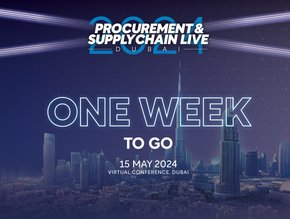The future for procurement risk management is data-driven

No stranger to risk, the procurement function has to battle many day-to-day challenges from a variety of sources. Such challenges can come from suppliers (financial stability, quality of product, service provided, delivery times, regulation compliance, ethical standards); markets (volatility, supply chain disruptions, demand changes, price fluctuations); operations (inefficiencies, inadequate controls, lack of transparency); and compliance (fraud, data privacy, labour practices, environmental impact).
Whilst there are many methods to mitigate risk, an emerging approach within procurement is ‘cognitive data-driven risk management’. Empowering businesses to make smarter decisions when securing their supply chain, “data-driven risk management is the future”, with there being “no feasible alternative”, according to Nicolas Walden, Associate Principal and UK & Europe Practice Leader, Procurement Advisory, The Hackett Group.
Using advanced data analytics and cognitive technologies – such as artificial intelligence (AI) and machine learning (ML) – to analyse data from suppliers, market trends, regulatory requirements, and internal processes, this approach identifies and mitigates potential risks in procurement.
“Cognitive data-driven risk management helps businesses identify and assess risks that are developing in our supply chains, as well as make more informed decisions to mitigate these risks. It’s used for the most critical supply chains, such as semiconductors, textiles, and automotive,” explains Walden.
“We’ve likely all seen what generative AI tools like ChatGPT and others can do to make our day more productive. Imagine the advantages once that capability can further empower our modern risk management solutions using machine learning, advanced decision-making models, and natural language programming.”
Benefits of cognitive data-driven risk management
Adopting cognitive data-driven risk management in procurement offers a competitive advantage to its users. Those in the function can proactively identify potential risks and develop effective strategies to mitigate them. As a result, the likelihood of experiencing supply chain disruptions reduces and overall risk management processes are improved.
“I see the key benefits as speed, productivity, and analysis. Modern supply chains are complex beasts with many moving parts. Plus, the list of supply risks is ever-growing; it is in the procurement team’s best interest to understand how risks may be developing, ranging from the classic financial or inventory risks, all the way through to geographical and geopolitical risk,” comments Walden.
He continues: “Artificial intelligence tools with powerful analytical capabilities are perfect to ingest, review, analyse, and bring to our attention the most important topics - sort of like finding that metaphorical needle in the haystack. For humans to perform the equivalent would unfeasibly require many more resources.”
Other benefits of cognitive data-driven risk management included supplier risk and performance management – often a top challenge for procurement professionals. Using the power of AL and ML to analyse supplier data can help procurement to gain better insights into supplier behaviour and associated risks to make more informed decisions during supplier evaluation, monitoring, and compliance management.
“Cognitive data-driven risk management for procurement is undoubtedly a major enabler for your organisations to keep you ahead of the curve in the dynamic business environment, where risks can surface abruptly and can have considerable threat to the bottom line, With the increasing complexity of global supply chains and growing regulatory requirements, cognitive data-driven risk management for procurement is becoming an essential tool to ensure compliance and minimise risks,” explains Zycus.
The challenges of adopting cognitive data-driven risk management
Like all strategies, cognitive data-driven risk management isn’t without its own set of challenges, with Walden explaining that “the most common challenge” is “access to high-quality, up-to-date data, and then feeding it to the AI so it can be acted on”.
“Another challenge is negotiating the limitations around how creative and innovative the AI can be, particularly in terms of proposing or recommending solutions to risks and issues. Artificial intelligence is fantastic at following business rules and logic. However, humans still have the advantage when it comes to creativity, innovation, and troubleshooting.”
In conclusion, implementing cognitive data-driven risk management requires lots of planning, high quality data, careful technology selection, training and evaluation. But getting this right, will be a recipe for success for procurement professionals to gain a competitive advantage when it comes to making smarter decisions when securing their supply chain.
- How IBM & AWS are Making Procurement Better Across the WorldTechnology & AI
- How SAP’s AI is Offering Cutting Edge Spend ManagementProcurement Strategy
- Logility Recognised as Leader in the Gartner Magic QuadrantTechnology & AI
- How Companies are Using AI to Navigate the ‘Polycrisis’Technology & AI






